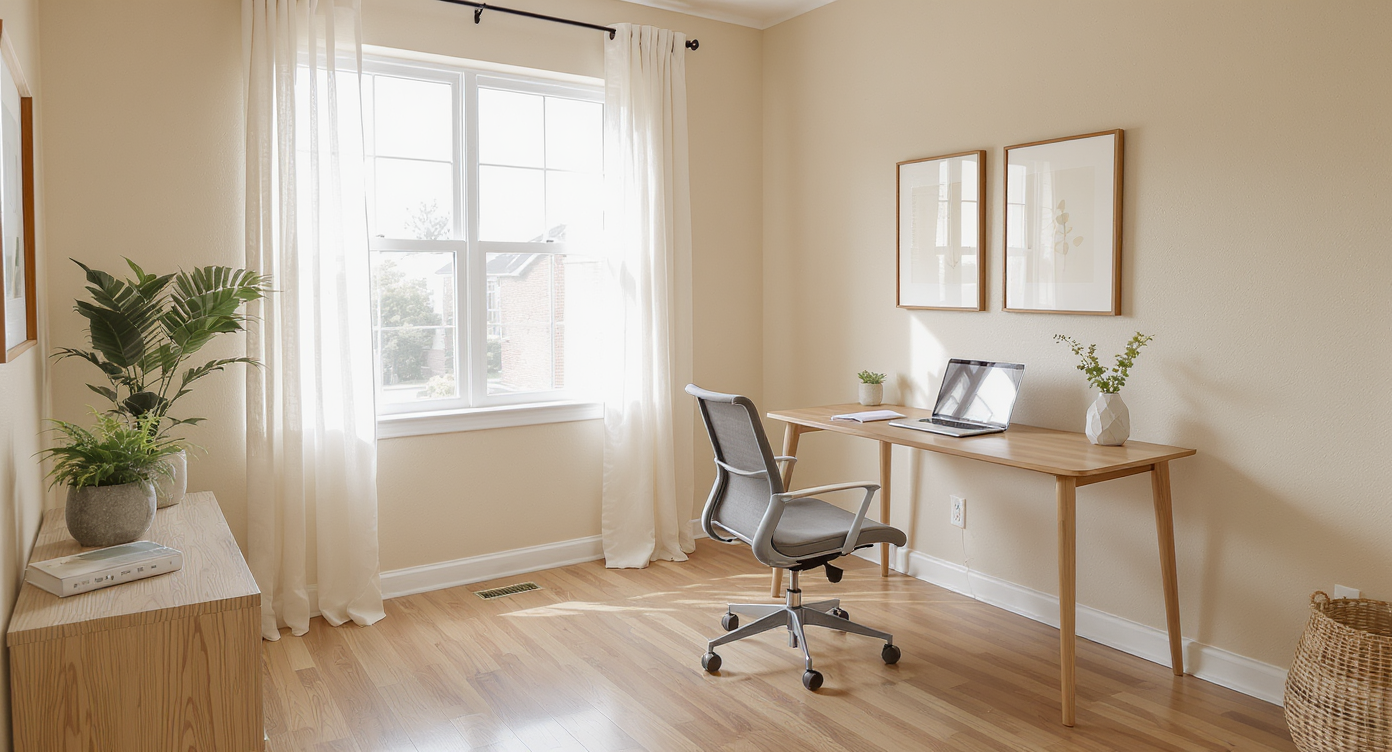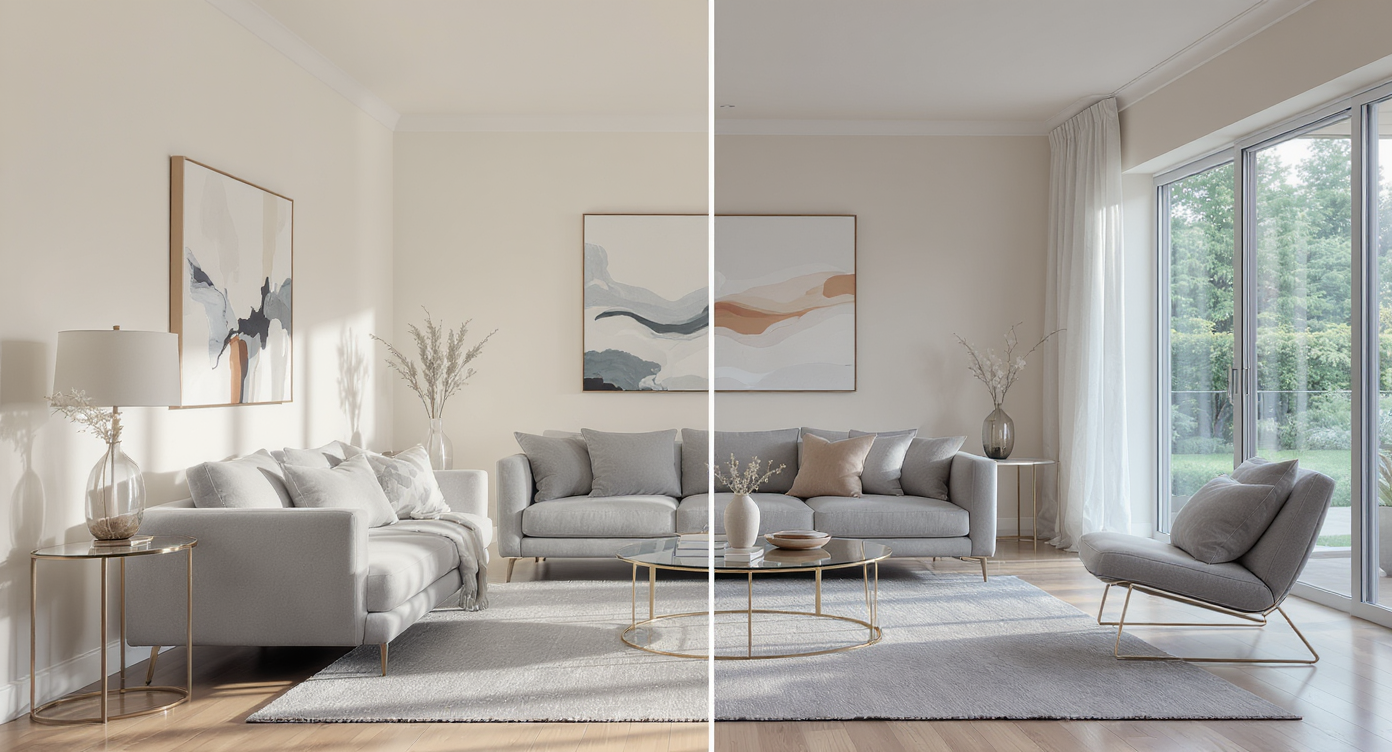TL;DR
Virtual staging can be a powerful real estate marketing tool when it’s disclosed and paired with originals. AI-edited listing photos that alter permanent features or dimensions are risky and often violate MLS rules. Use virtual staging for real estate listings to clarify potential, not to conceal reality.
AI in Property Photos: A Fast Line to Faster Clicks—or Faster Complaints

A serene home office exemplifies how authentic photos set honest expectations in today’s real estate market.
In today’s real estate marketing landscape, property photos do more than introduce a home—they set expectations. With 90%+ of buyers starting online, first impressions decide who books a showing and who keeps scrolling. That’s why virtual staging and AI-enhanced listing photos are surging, especially on mobile. Here’s the thing: there’s a hard line between virtual staging that illustrates possibilities and AI edits that misrepresent a property. Buyers can accept a sofa that isn’t really there. They won’t forgive windows that look new online and old in person. Market analysts suggest that trust, not tricks, is what converts clicks into contracts.
What’s Allowed, What’s Not
“Virtual staging is fine when disclosed. Altering permanent features is not.” That’s the rule of thumb agents and MLS administrators repeat. - Virtual staging is allowed when you clearly label it and show the unedited photo alongside. Agents often advise: pair each staged image with the original in the very next slide and add a visible caption like “Virtually staged.” - Misrepresentation crosses the line. Most MLS rules and state licensing laws prohibit altering fixed features—dimensions, windows, ceiling height, flooring material, or removing defects. Market compliance teams routinely fine agents for this, with penalties ranging from a few hundred dollars to more than $1,000 per violation. - Why it matters: Listings with staged photos see 30–50% higher click-through in brokerage A/B tests, but those gains evaporate if buyers feel duped at the door. Homebuyers today expect transparency and will walk if photos feel fake. How to do it right in five steps: 1) Disclose virtual staging in the caption and again in the remarks. The first sentence of the section should state: disclose virtual staging in both places. 2) Pair or overlay. Show the original right after the staged version or use a split-screen image labeled “Before/After.” 3) Don’t move walls or change architecture. Keep window sizes, ceiling heights, stair locations, and room widths accurate. 4) Provide context. Add a floor plan with measurements and a 3D tour. Surveys consistently rank floor plans just behind photos as the most helpful listing asset for buyers. 5) Keep a paper trail. Save originals, edits, and your disclosure language. Brokers and MLS admins say documentation resolves most complaints in minutes.
Anecdote
A listing agent once told me she switched from glossy, heavily edited interiors to paired originals plus staged images—and saw fewer cancellations after showings. The secret wasn’t the sofa. It was the side-by-side truth.
Common Mistakes That Get Listings Flagged
“The fastest way to lose trust is to promise a room that doesn’t exist.” Agents often advise avoiding the traps below.
- Editing permanent features: Changing window size, removing a staircase, shifting wall lines, or widening a kitchen island. Fix: Only add or remove non-fixed items—furniture, rugs, decor.
- No disclosure: Posting AI-enhanced images without labeling them “virtually staged” or “digitally edited.” Fix: Put disclosure in the photo caption and listing remarks.
- Separate “fantasy” listings: Creating a second listing with AI images to boost traffic. Fix: One listing, transparent images, consistent file names.
- Hiding defects: Erasing stains, cracks, utility poles, or neighboring structures. Fix: Show reality; if you virtually repair, include the untouched photo immediately after.
- Overcooking exposure and wide angles: Making spaces look twice their size. Fix:Photographers recommend modest wide angles (16–24mm full-frame) and perspective correction to keep rooms recognizable.
Pro Tips Agents Use to Keep It Honest—and Effective
“Stage for phones first—roughly 80% of listing views happen on mobile,” say brokerage marketing teams who study their analytics.
- Label every edited image. Put “Virtually staged” directly on the photo and repeat in the caption. Include suggested alt text in your media notes: “Alt text: Living room, virtually staged with contemporary sofa and rug; original shown next.”
- Show measurements. Add a measured floor plan. Buyers decide faster when they can see a queen bed, a 72-inch sofa, and a 36-inch dining table drawn to scale.
- Use lighting honestly. Aim for natural color temperatures around 5000K. Market photographers suggest keeping interiors within 0.5–1 stop of reality to avoid “cartoon” lighting.
- Offer a 3D tour. Matterport-style tours reduce tire-kickers; providers report up to 49% more qualified leads when tours are included.
- Lean on compliant tools. Platforms like ReimagineHome let you swap styles and declutter digitally while keeping walls, windows, and proportions intact.
Real Stories from the Field
Real buyers and sellers are already rewriting their playbooks around AI and virtual staging. - The first-time buyer: A couple toured a “light-filled” bungalow only to find small windows and low ceilings. The photos had been brightened and shot ultra-wide. They skipped the offer, then later wrote to the broker asking that the listing add a floor plan and unedited exposures. The next weekend, the property drew more serious buyers. - The fined team: A coastal team swapped in AI windows and a sleeker front door. The local MLS flagged the images within 24 hours. The broker paid a four-figure fine and replaced the media with paired originals and labeled virtual staging. Showings improved, complaints vanished. - The transparent stager: A veteran stager digitally decluttered a crowded family room, labeling the image and placing the original first. The agent noted 35% more saves and two offers in the first week. Buyers said they appreciated seeing “real vs. potential” back-to-back. - The investor’s lesson: An investor toured a “remodeled” kitchen that was only virtually updated. He didn’t mind—because the listing clearly said “virtual renovation concept” and included cost estimates. He bought, then used the rendering as a punch list for contractors. Quotable: “Concept renders can sell a vision, but only when they’re clearly marked as concepts,” say developers who pre-market fixers.
Visualization Scenario
Picture a buyer on a phone at 11 p.m., flipping through listing photos. Slide one: the real living room. Slide two: the same room, virtually staged with a sectional and a 5-by-8 rug. The caption reads, “Virtually staged—original shown next.” A measured floor plan sits in the gallery. The buyer can now feel the scale, not guess it. That’s the difference between a save and a swipe.
FAQ
How should I use virtual staging for real estate listings without misleading buyers?
Use virtual staging for real estate listings only to add furniture or decor, label each image, and pair it with the original. This protects trust and complies with most MLS rules on real estate photos.
Are AI real estate photos legal on MLS listing photos?
AI is allowed when edits are disclosed and do not alter permanent features or dimensions. Misrepresentation of property photos can trigger MLS fines and state licensing penalties.
How much does virtual staging cost for real estate agents and sellers?
Basic virtual staging of property photos typically runs $25–$100 per image; advanced virtual renovation, decluttering, or day-to-dusk can cost $75–$300 per image. Bulk packages often lower the per-photo price.
Can buyers tell if photos are virtually staged, and do staged listing photos sell faster?
When labeled, buyers recognize virtual staging and use it to visualize scale. Agents report staged photos get 30–50% more clicks, and seller surveys often show 1–5% higher offers when presentation is strong.
What’s the best way to market real estate listings online with authentic property photos?
Combine honest property photos, a measured floor plan, and a 3D tour, then add transparent virtual staging for context. This listing strategy meets buyer expectations and improves lead quality.
The Takeaway: Sell a Story, Not a Fiction
Let’s be real: great real estate marketing isn’t about perfect photos. It’s about credible ones that earn showings and offers. Use virtual staging to clarify scale, layout, and livability. Use captions, paired originals, floor plans, and tours to keep it honest. If you’re an agent, think like a storyteller with receipts. If you’re a buyer, look for labels, floor plans, and a 3D tour before booking a Saturday. The fastest route to a signed contract is still the simplest: show the home as it is, then show what it could be—clearly.




.svg)

.svg)



.png)